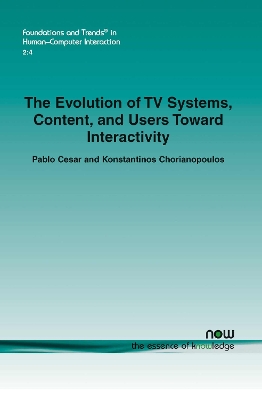Foundations and Trends (R) in Human-Computer Interaction
1 total work
The Evolution of TV Systems, Content, and Users Towards Interactivity
by Pablo Cesar and Konstantinos Chorianopoulos
Published 18 August 2009
Provides an overview of the evolution of TV systems, TV content, and TV users towards interactivity, with a special focus on sociability aspects. Three basic concepts are introduced, namely, content editing, content sharing, and content control. Content editing corresponds to the activity of developing or organizing multimedia material, traditionally the domain of professionals but also including user-generated content. Content sharing refers to all kinds of social activities that might occur around television watching, such as chatting about television content and sharing content. Finally, content control corresponds to the activity of deciding what to watch and how to watch it.
A simple taxonomy (edit-share-control) is proposed as an evolutionary step over the established hierarchical produce-deliver-consume paradigm. This book looks at how research in the area has spanned a rather diverse set of scientific subfields, such as multimedia, HCI, CSCW, UIST, user modeling, media and communication sciences. It demonstrates how each disciplinary effort has contributed and why the full potential of interactive TV has not yet been fulfilled. Finally, it describes how interdisciplinary approaches could provide solutions to some notable contemporary research issues.
The Evolution of TV Systems, Content, and Users towards Interactivity is aimed at students and researchers, practitioners and developers. It assumes a basic understanding of past and current practices on the design of computer applications, networks and media content.
A simple taxonomy (edit-share-control) is proposed as an evolutionary step over the established hierarchical produce-deliver-consume paradigm. This book looks at how research in the area has spanned a rather diverse set of scientific subfields, such as multimedia, HCI, CSCW, UIST, user modeling, media and communication sciences. It demonstrates how each disciplinary effort has contributed and why the full potential of interactive TV has not yet been fulfilled. Finally, it describes how interdisciplinary approaches could provide solutions to some notable contemporary research issues.
The Evolution of TV Systems, Content, and Users towards Interactivity is aimed at students and researchers, practitioners and developers. It assumes a basic understanding of past and current practices on the design of computer applications, networks and media content.
